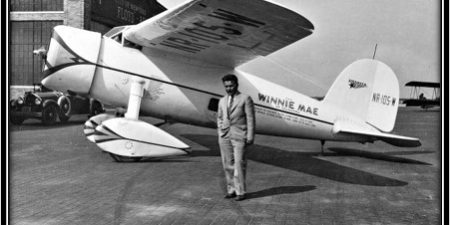Wiley Post
Contributor: Barry Fetzer
Sources: History.com and Wikipedia
Hello again fellow lovers of aviation history. This historical vignette reminds me of the story of “Lucky”, the mangey, stray, three-legged, castrated, one-eyed, “Heinz-57” (mixed breed) dog that despite his adversities somehow was still making it in the canine world…somehow had found a way to survive and thrive.
Blinded in one eye, convicted of and serving hard time for armed robbery, and derided because of doubts people had about him due to his rural background and limited formal education (6th grade) and the mixed-race Cherokee heritage of his mother, Wiley Post taught himself to fly, ultimately rising above his earlier mishaps and his failures, and proved his detractors wrong. On this day in 1933 according to History.com, “American aviator Wiley Post returned to Floyd Bennett Field in New York, having flown solo around the world in 7 days, 18 hours, and 49 minutes. He was the first aviator to accomplish the feat.”
From Wikipedia: “Wiley Hardeman Post (November 22, 1898 – August 15, 1935) was a famed American aviator during the interwar period and the first pilot to fly solo around the world. He was also known for his work in high-altitude flying. Post helped develop one of the first pressure suits and discovered the jet stream. During World War I Post wanted to become a pilot in the U.S. Army Air Service. Germany agreed to an armistice before he completed his training, the war ended, and he went to work as a ‘roughneck’ in the Oklahoma oilfields. The work was also unsteady, and he turned briefly to armed robbery. He was arrested in 1921 and sent to the Oklahoma State Reformatory, serving more than a year there. He was paroled in summer 1922.
Post’s aviation career began at age 26 as a parachutist for a flying circus, Burrell Tibbs and His Texas Topnotch Fliers, and he became well-known on the barnstorming circuit. On October 1, 1926, Post was badly injured in an oil-rig accident when a piece of metal pierced his left eye (an infection permanently blinded him in that eye, and he typically wore an eyepatch thereafter), but he used the settlement money to buy his first aircraft.”
Again from History.com: “Post, instantly recognizable by the patch he wore over one eye, began the round the world journey on July 15, flying nonstop to Berlin. After a brief rest, he flew on to the Soviet Union, where he made several stops before returning to North America, with stops in Alaska, Canada, and finally a triumphant landing at his starting point in New York.
 Wiley Post
Wiley Post
Two years earlier, Post had won fame when he successfully flew around the northern part of the earth with aviator Harold Gatty.”
Again, according to Wikipedia, “In 1930, the record for flying around the world was not held by a fixed-wing aircraft, but by the rigid airship Graf Zeppelin, piloted by Hugo Eckener in 1929 with a time of 21 days. On June 23, 1931, Post and the Australian navigator Harold Gatty left Roosevelt Field on Long Island, New York, in the Winnie Mae with a flight plan that would take them around the world, stopping at Harbour Grace, Flintshire, Hanover twice, Berlin, Moscow, Novosibirsk, Irkutsk, Blagoveshchensk, Khabarovsk, Nome (where his propeller had to be repaired), Fairbanks (where the propeller was replaced), Edmonton, and Cleveland before returning to Roosevelt Field. They arrived back on July 1, after traveling 15,474 miles (24,903 km) in the record time of 8 days and 15 hours and 51 minutes, in the first successful aerial circumnavigation by a single-engined monoplane. The reception they received rivaled Charles Lindbergh’s everywhere they went.”
 Post with the Lockheed Vega Winnie Mae
Post with the Lockheed Vega Winnie Mae
And again from History.com: “For his solo around-the-world flight in 1933, he flew a slightly greater distance–15,596 miles–in less time. For both flights, he used the Winnie Mae, a Lockheed Vega monoplane that was equipped with a Sperry automatic pilot and a direction-finding radio for Post’s solo journey.
In August 1935, he was attempting to fly across the North Pole to the USSR with American humorist Will Rogers when both men were killed in a crash near Point Barrow, Alaska.”
Sadly, we lost Post as a young man before he could achieve even more.
Let’s hear it for rising above our circumstances, for keeping-on-keeping on, and for striving successfully to achieve one’s dreams! Post exemplified each of these valuable traits. Just like our mangey mutt, Lucky.







